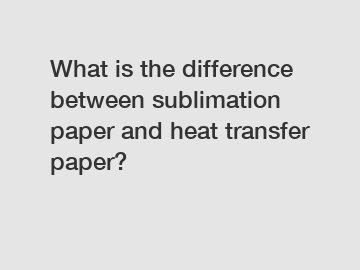What is the difference between sublimation paper and heat transfer paper?
What is the difference between sublimation paper and heat transfer paper?
When it comes to printing on fabrics or other materials, there are several methods available, two of which are sublimation printing and heat transfer printing. Both techniques have their advantages and are preferred for different applications. Understanding the difference between sublimation paper and heat transfer paper is essential in order to choose the right method for your specific needs.
Sublimation Printing:

Sublimation printing is a process in which heat and pressure are used to transfer dye onto materials like fabrics, ceramics, and metal. Sublimation ink is used, which transforms from a solid to a gas when heated. This gas then embeds itself into the material, resulting in vibrant, long-lasting prints.
Sublimation paper is specially coated to accept the sublimation ink. The image is printed in reverse onto the sublimation paper, and then heat is applied using a heat press. The heat causes the ink to turn into a gas, which bonds with the fibers of the material. As the gas cools, it solidifies and becomes a permanent part of the material. This process ensures that the print is durable, washable, and resistant to fading or cracking.
Advantages of sublimation printing include:
1. Vibrant Colors: Sublimation printing allows for high-definition, vibrant colors that are long-lasting and resistant to fading.
2. Durability: The prints created through sublimation are highly durable and can withstand frequent washing without losing their quality.
3. Soft Touch: Sublimation prints have a soft touch because the ink is integrated into the fabric instead of sitting on top of it.
Heat Transfer Printing:
Heat transfer printing, also known as iron-on or t-shirt transfer printing, is a process in which an image or design is printed onto a transfer paper and then applied to the material using heat and pressure. Heat transfer paper is specifically created to transfer the ink onto fabrics.
The image is printed in reverse onto the heat transfer paper using an inkjet or laser printer. The paper is then placed onto the fabric, and heat is applied using a heat press or iron. The heat causes the ink to melt and bind with the fibers of the fabric, creating a permanent print.
Advantages of heat transfer printing include:
1. Versatility: Heat transfer printing can be used on a variety of materials, including fabrics, ceramics, and metals.
2. Cost-effective: Heat transfer printing is a cost-effective method for small-scale production or personal use, as it doesn't require expensive equipment or extensive setup.
3. Easy to Do: Heat transfer printing can be done at home with basic equipment like an iron.
Conclusion:
In conclusion, the main difference between sublimation paper and heat transfer paper lies in the printing process and the type of ink used. Sublimation paper is used for sublimation printing, where the ink turns into a gas and bonds with the material. On the other hand, heat transfer paper is used for heat transfer printing, where the ink melts and binds with the fabric.
Both techniques have their advantages and it is important to consider your specific requirements before choosing the right method. Whether you need vibrant, durable prints for professional applications or want to create personalized products at home, knowing the difference between sublimation paper and heat transfer paper will help you make an informed decision.
If you have any further questions or need assistance in choosing the right printing method for your needs, please feel free to contact us.
For more heat transfer paper vs sublimation paper, transfer printing paper for polyester, sublimation paper typesinformation, please contact us. We will provide professional answers.


